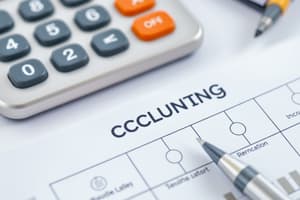Podcast
Questions and Answers
What is the purpose of the adjusting entries in the Accounting Cycle?
What is the purpose of the adjusting entries in the Accounting Cycle?
- To ensure that revenue and expenses are recognized in the proper accounting period. (correct)
- To summarize all account balances at the end of an accounting period.
- To correct errors made in previous journal entries.
- To prepare the financial statements for external reporting.
What is the main difference between batch processing and real-time processing?
What is the main difference between batch processing and real-time processing?
- Batch processing is used for financial transactions, while real-time processing is used for non-financial transactions.
- Real-time processing is more accurate than batch processing.
- Batch processing is more efficient than real-time processing.
- Batch processing processes transactions in groups, while real-time processing processes transactions individually. (correct)
Which of the following statements is TRUE about posting in the Accounting Cycle?
Which of the following statements is TRUE about posting in the Accounting Cycle?
- Posting is the process of transferring information from the journal to the ledger. (correct)
- Posting is the process of analyzing transactions and recording them in the journal.
- Posting is the process of adjusting the accounts at the end of an accounting period.
- Posting is the process of preparing the financial statements.
What is the purpose of the work sheet in the Accounting Cycle?
What is the purpose of the work sheet in the Accounting Cycle?
What is the primary purpose of the closing entries in the Accounting Cycle?
What is the primary purpose of the closing entries in the Accounting Cycle?
What is the purpose of a reversing entry?
What is the purpose of a reversing entry?
What is the difference between a trial balance and an adjusted trial balance?
What is the difference between a trial balance and an adjusted trial balance?
Which of the following is NOT a type of transaction processed by a transaction processing system (TPS)?
Which of the following is NOT a type of transaction processed by a transaction processing system (TPS)?
What is one disadvantage of data representation methods mentioned?
What is one disadvantage of data representation methods mentioned?
Which coding technique is likely to be difficult for users to sort?
Which coding technique is likely to be difficult for users to sort?
What is a characteristic of mnemonic codes?
What is a characteristic of mnemonic codes?
What coding technique allows for a dramatic increase in the capacity to represent large items?
What coding technique allows for a dramatic increase in the capacity to represent large items?
What is a limitation of using mnemonic codes?
What is a limitation of using mnemonic codes?
Which of the following is a temporary file used to update master files?
Which of the following is a temporary file used to update master files?
What type of file holds historical data that can be used for future reference?
What type of file holds historical data that can be used for future reference?
Which of the following contains the account data that is constantly updated?
Which of the following contains the account data that is constantly updated?
What type of file stores standards and guidelines used for processing transactions?
What type of file stores standards and guidelines used for processing transactions?
Which record is used to trace account balances back to the source documents?
Which record is used to trace account balances back to the source documents?
Which of the following records would you use to investigate specific details related to a specific customer?
Which of the following records would you use to investigate specific details related to a specific customer?
What is the name used to describe the detailed records kept within a ledger, that contain the specific information for a single control account?
What is the name used to describe the detailed records kept within a ledger, that contain the specific information for a single control account?
How do digital accounting records differ from manual records when it comes to establishing an audit trail?
How do digital accounting records differ from manual records when it comes to establishing an audit trail?
What type of model describes an environment where individual data files are unrelated?
What type of model describes an environment where individual data files are unrelated?
Which of the following is a significant problem associated with the flat-file model?
Which of the following is a significant problem associated with the flat-file model?
In a flat-file system, which issue arises due to the inability to disseminate updates properly?
In a flat-file system, which issue arises due to the inability to disseminate updates properly?
What describes the constraint on a user's information set in a flat-file model?
What describes the constraint on a user's information set in a flat-file model?
Which of the following techniques is used extensively by systems analysts to represent logical elements of a system?
Which of the following techniques is used extensively by systems analysts to represent logical elements of a system?
What does an Entity Relationship Diagram (ER) specifically represent?
What does an Entity Relationship Diagram (ER) specifically represent?
What major drawback does the flat-file database model present concerning data updating?
What major drawback does the flat-file database model present concerning data updating?
Data integration in a flat-file model is challenging primarily due to which factor?
Data integration in a flat-file model is challenging primarily due to which factor?
What does the term 'cardinality' refer to in a data model?
What does the term 'cardinality' refer to in a data model?
What is the primary focus of an Entity-Relationship (ER) diagram?
What is the primary focus of an Entity-Relationship (ER) diagram?
Which diagram is used to verify the correctness of program logic?
Which diagram is used to verify the correctness of program logic?
Which of the following statements correctly describes a system flowchart?
Which of the following statements correctly describes a system flowchart?
What is one function of record layout diagrams?
What is one function of record layout diagrams?
Which type of diagram models system processes?
Which type of diagram models system processes?
Which of the following components are part of the expenditure cycle?
Which of the following components are part of the expenditure cycle?
In data modeling, what is one-to-many (1:M) cardinality?
In data modeling, what is one-to-many (1:M) cardinality?
Which documentation technique provides a blueprint for the physical database?
Which documentation technique provides a blueprint for the physical database?
What is the primary purpose of the conversion cycle?
What is the primary purpose of the conversion cycle?
What is a key characteristic that distinguishes the revenue cycle from the expenditure cycle?
What is a key characteristic that distinguishes the revenue cycle from the expenditure cycle?
Which of the following statements is true about the expenditure cycle?
Which of the following statements is true about the expenditure cycle?
What is the primary role of source documents in accounting records?
What is the primary role of source documents in accounting records?
Which of the following is NOT a characteristic of a financial transaction?
Which of the following is NOT a characteristic of a financial transaction?
Which of the following best describes the relationship between the conversion cycle and the expenditure cycle?
Which of the following best describes the relationship between the conversion cycle and the expenditure cycle?
Which of the following is NOT a key component of the conversion cycle?
Which of the following is NOT a key component of the conversion cycle?
Flashcards
Data Representation
Data Representation
Facilitates logical depiction of diverse datasets for analysis.
Data Coding Schemes
Data Coding Schemes
Methods used to encode data such as alphabetic and numeric codes.
Alphabetic Codes
Alphabetic Codes
Codes using letters to represent information, akin to numeric codes.
Mnemonic Codes
Mnemonic Codes
Signup and view all the flashcards
Advantages of Coding
Advantages of Coding
Signup and view all the flashcards
Financial Transaction
Financial Transaction
Signup and view all the flashcards
Expenditure Cycle
Expenditure Cycle
Signup and view all the flashcards
Conversion Cycle
Conversion Cycle
Signup and view all the flashcards
Revenue Cycle
Revenue Cycle
Signup and view all the flashcards
Time Lag
Time Lag
Signup and view all the flashcards
Physical Component
Physical Component
Signup and view all the flashcards
Financial Component
Financial Component
Signup and view all the flashcards
Source Documents
Source Documents
Signup and view all the flashcards
Cardinality
Cardinality
Signup and view all the flashcards
Data Model
Data Model
Signup and view all the flashcards
DFD
DFD
Signup and view all the flashcards
ER Diagram
ER Diagram
Signup and view all the flashcards
System Flowchart
System Flowchart
Signup and view all the flashcards
Program Flowchart
Program Flowchart
Signup and view all the flashcards
Record Layout Diagrams
Record Layout Diagrams
Signup and view all the flashcards
Documentation Techniques
Documentation Techniques
Signup and view all the flashcards
Flat-file model
Flat-file model
Signup and view all the flashcards
Data redundancy problems
Data redundancy problems
Signup and view all the flashcards
Data Storage Cost
Data Storage Cost
Signup and view all the flashcards
Data Updating Issues
Data Updating Issues
Signup and view all the flashcards
Currency of Information
Currency of Information
Signup and view all the flashcards
Task-Data Dependency
Task-Data Dependency
Signup and view all the flashcards
Data Integration Challenges
Data Integration Challenges
Signup and view all the flashcards
Data Flow Diagram (DFD)
Data Flow Diagram (DFD)
Signup and view all the flashcards
Accounting Cycle
Accounting Cycle
Signup and view all the flashcards
Journalization
Journalization
Signup and view all the flashcards
Posting
Posting
Signup and view all the flashcards
Trial Balance
Trial Balance
Signup and view all the flashcards
Adjustments
Adjustments
Signup and view all the flashcards
Adjusted Trial Balance
Adjusted Trial Balance
Signup and view all the flashcards
Financial Statements
Financial Statements
Signup and view all the flashcards
Reversing Entries
Reversing Entries
Signup and view all the flashcards
General Ledger
General Ledger
Signup and view all the flashcards
Subsidiary Ledger
Subsidiary Ledger
Signup and view all the flashcards
Audit Trail
Audit Trail
Signup and view all the flashcards
Control Accounts
Control Accounts
Signup and view all the flashcards
Master File
Master File
Signup and view all the flashcards
Transaction File
Transaction File
Signup and view all the flashcards
Reference File
Reference File
Signup and view all the flashcards
Archive File
Archive File
Signup and view all the flashcards
Study Notes
The Accounting Cycle
- The accounting cycle is a series of steps used to record and report financial transactions.
- It begins with transactions (documents) and ends with financial statements.
- The steps in the cycle are:
-
- Journalization: Recording transactions in a journal.
-
- Posting: Transferring journal entries to ledger accounts.
-
- Trial balance: Verification that debits equal credits.
-
- Adjustments: Making necessary corrections for accruals, deferrals, etc.
-
- Adjusted trial balance: Adjusted balances of accounts.
-
- Financial Statements: Summarizing financial performance and position.
-
- Closing entries: Closing temporary accounts (revenues, expenses, dividends).
-
- Post-closing trail balance: Balance sheet accounts after closing.
-
- Reversing entries: Adjusting for accruals and deferrals from prior period.
-
Introduction to Transaction Processing
- A financial transaction affects assets and equities of the firm.
- It's recorded in the firm's accounts and measured in monetary terms.
- Transaction cycles include: Expenditure cycle, Conversion cycle, and Revenue cycle.
- Expenditure cycle: Involves incurring expenditures for resources.
- Conversion Cycle: Adding value to products or services.
- Revenue Cycle: Involving revenue from outside sources.
Objectives for Chapter 2
- Understanding transaction cycles is essential.
- Recognizing types of transactions is important.
- Knowing basic accounting records in TPS is fundamental.
- Understanding the relationship between traditional and computer-based accounting records is vital.
- Familiarity with documentation techniques is useful.
- Understanding differences between batch and real-time processing is key.
- Knowing data coding schemes in AIS is a must.
Accounting Records: Manual Systems
- Source documents formalize transaction data capture.
- Product documents result from transactions, becoming source documents for other systems.
- Turnaround documents are product documents used as input for another system.
- Journals: chronological records of transactions.
- Special journals record frequently occurring transactions.
- Registers are specific types of special journals.
- General journals record nonrecurring, infrequent, and dissimilar transactions.
- Ledgers are books of accounts reflecting financial effects of a firm's transactions.
- General ledgers summarize account information.
- Subsidiary ledgers provide details for each of the individual accounts within a particular control account.
- Accounting records provide an audit trail by tracing financial statement balances back to source documents.
Digital Accounting Records
- Master file stores account data.
- Transaction file is used to update master file data.
- Reference file provides standards for transactions.
- Archive file stores past transactions for reference.
- Digital records form an audit trail, although less visible than in hard-copy documents.
File Structures
- Flat-file model has data files not related to each other, causing data redundancy problems.
- Problems include issues with data storage, data updates and currency of information.
- Other challenges include task data dependency and data integration.
Data Coding Schemes
-
Coding is used to efficiently process large numbers of transactions.
-
Uncoded records are difficult to track, prone to error.
-
Coding schemes (e.g. numeric, mnemonic) allow for efficient storage and reporting of data.
-
Coding schemes help to manage and track vast quantities of transactions.
Studying That Suits You
Use AI to generate personalized quizzes and flashcards to suit your learning preferences.





